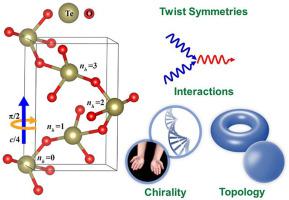Materials Today Physics ( IF 10.0 ) Pub Date : 2021-09-30 , DOI: 10.1016/j.mtphys.2021.100548 R. Juneja 1 , S. Thébaud 1 , T. Pandey 1, 2 , C.A. Polanco 1 , D.H. Moseley 1 , M.E. Manley 1 , Y.Q. Cheng 3 , B. Winn 3 , D.L. Abernathy 3 , R.P. Hermann 1 , L. Lindsay 1

|
Quasiparticle physics underlies our understanding of the microscopic dynamical behaviors of materials that govern a vast array of properties, including structural stability, excited states and interactions, dynamical structure factors, and electron and phonon conductivities. Thus, understanding band structures and quasiparticle interactions is foundational to the study of condensed matter. Here we advance a ‘twist’ dynamical description of quasiparticles (including phonons and Bloch electrons) in non-symmorphic chiral and achiral materials. Such materials often have structural complexity, strong thermal resistance, and efficient thermoelectric performance for waste heat capture and clean refrigeration technologies. The twist dynamics presented here provides a novel perspective of quasiparticle behaviors in such complex materials, in particular highlighting how non-symmorphic symmetries determine band crossings and anti-crossings, topological behaviors, quasiparticle interactions that govern transport, and observables in scattering experiments. We provide specific context via neutron scattering measurements and first-principles calculations of phonons and electrons in chiral tellurium dioxide. Building twist symmetries into the quasiparticle dynamics of non-symmorphic materials offers intuition into quasiparticle behaviors, materials properties, and guides improved experimental designs to probe them. More specifically, insights into the phonon and electron quasiparticle physics presented here will enable materials design strategies to control interactions and transport for enhanced thermoelectric and thermal management applications.
中文翻译:

非对称材料中的准粒子扭曲动力学
准粒子物理学是我们理解材料微观动力学行为的基础,这些行为控制着大量性质,包括结构稳定性、激发态和相互作用、动力学结构因素以及电子和声子电导率。因此,理解能带结构和准粒子相互作用是研究凝聚态的基础。在这里,我们提出了非对称手性和非手性材料中准粒子(包括声子和布洛赫电子)的“扭曲”动力学描述。此类材料通常具有结构复杂、耐热性强以及用于废热捕获和清洁制冷技术的高效热电性能。这里介绍的扭曲动力学提供了这种复杂材料中准粒子行为的新视角,特别强调了非对称对称性如何确定带交叉和反交叉、拓扑行为、控制传输的准粒子相互作用以及散射实验中的可观察量。我们通过中子散射测量和手性二氧化碲中声子和电子的第一性原理计算提供特定背景。将扭曲对称性构建到非对称材料的准粒子动力学中,可以直观地了解准粒子行为、材料特性,并指导改进的实验设计来探测它们。更具体地说,对此处介绍的声子和电子准粒子物理学的深入了解将使材料设计策略能够控制相互作用和传输,以增强热电和热管理应用。











































 京公网安备 11010802027423号
京公网安备 11010802027423号